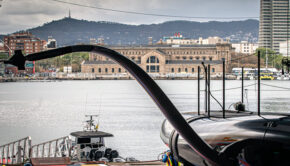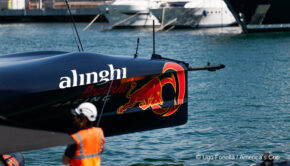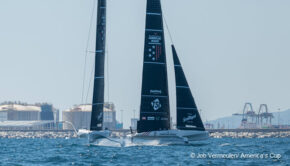America’s Cup: It is the Anticipation that We Love
Published on August 28th, 2013
The Auld Mug is getting tugged on in so many directions. History pulls it one way, commercial interests pull another way. The cost to compete remains high, and the inmates remain in charge of the asylum.
The suggestion of one design boats, some believe, will solve many of the problems. But as English yacht designer Dave Hollom reminds us, that change would neglect some very important points that are pertinent to the long term interest and success of the event….
The build up to any event is as important if not more important than the event itself. It is the anticipation of what is to come that holds the onlookers interest. More often than not, the build-up ends up being more interesting than the event itself which, as we have so often seen, can be an anti-climax.
The build-up consists of examining the preparations of the competing teams. In any technical sport that allows some development in the equipment used, there is a huge reservoir of talking points centered on the equipment itself. Just pick up a copy of Autosport and look at the pages devoted to technical development.
Yes, there are articles about drivers but there are just as many about the latest technical developments, or about designers or about other technicians or about the regulations themselves and about how designers and technicians get the best out of the rules..
Most people are interested in the technicalities of a sport. They are not as technically numb as some people would have us believe. They appreciate the cleverness of the designer who finds a loophole or a more efficient way of doing something and look forward with expectation to see how it works.
The human race is curious. It is a natural human trait to ask questions about things we do not understand and to try and find answers to those questions and there is a certain satisfaction in discovering the answer and understanding its implications.
The America’s Cup really started to gain worldwide interest and publicity in 1983 when ‘Australia 2’ won. It wasn’t what Dennis Conner or John Bertrand had for breakfast that interested them; it was the extraordinary technical innovation of ‘Australia 2’s’ keel.
A single technical innovation took the America’s Cup from the backwaters of a small minority sport and projected it onto the world stage. True, Dennis’ gritty fightback and the wind and waves of Fremantle gripped the public’s imagination, but that would never have happened without the technical innovation of ‘Australia 2’.
A technical sport needs characters but it also needs technical innovation. Tom Blackaller attracted many column inches but his technically clever boat attracted at least as many more.
Take design and innovation away from a technical event and there isn’t too much to talk about during the run up, and during the event itself the expectation of how these different concepts and designs will work, is lost.
Pick up a copy of the aforementioned Autosport and see how much of the magazine is devoted to Formula One, which is a development series, and compare it to the coverage of Indy car racing which is, to all intents and purposes, a one design series and you will see what I mean, and a large part of that additional coverage is technical in nature. Admittedly Autosport is a British magazine and Indycar is an American invention but you only have to look at the success of Formula One worldwide compared to Indycar and you have your answer.
The raison d’e etre of one designs is that they cost less and the competition is, supposedly, more equal and that is the reason why Indycar has developed, or if you like, descended into a one design event. When design was reasonably free in the series there was very much more interest, certainly on this side of the pond, than there is now. So is the reduction in cost worth the reduction in publicity? And is one design racing any closer than development class racing?
If you really want to reduce the costs, have a sensible financial budget that each team must work within, and if you want close racing don’t keep changing the design rules. Every time you change the rules, because none of the possible design paths have been explored, you expand the number of solutions to the design problem and one team will likely find a better solution than the others and then you have a non-event.
With stable rules many of the design paths have been explored and the chances of one or other design team coming up with a design breakthrough, though still possible, is very much more remote and the relative performance between different boats will likely be very close. Also, because there will be a ready supply of older boats to use as trial horses, new syndicates will have a better starting point and because there will then be a demand for older boats they will hold their value better, so everybody gains.








 We’ll keep your information safe.
We’ll keep your information safe.